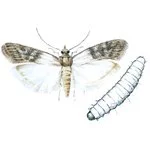
Indian meal moths are also called chocolate moths Among the moths that can go into our foods, the Indian meal moth (Plodia interpunctella) is most likely to occur in households, shops and food.
It is actually a pretty little butterfly, 1 cm. from antennae to the rear.
The wings are two-toned, the front third is light grey, the rest has a warm red-brown colour.
These moths fly mostly in the dusk, but are attracted by light. In the day, they sit on walls with the wings covering their rear.
The adult female moth lays eggs – up to 500 – in dry plant products. She can lay eggs in flour and cereals, but prefers dried fruit such as prunes, dates and raisins but also nuts, almonds and cocoa beans belong to her favourites.
When the eggs hatch, they small larvae start feeding. The look like typical caterpillars with a dark head, provided with powerful jaws and the body is provided with three pairs of legs and five pairs of prolegs. When conditions are favourable, they have food and a temperature around 25 degrees C. they become full-grown in a good month and then they are ready to pupate. Like other caterpillars – the silk moth is the most famous – they can produce silk, and silk threads in the infested items it is a sure sign that moth larvae are present.
When the time of pupation approaches, the larvae become restless and seek out of whatever has been their home and pantry. In contrast to the adult moth they gnaw and they can easily gnaw through cardboard and plastic packaging. Usually they seek upward, and in this stage, you can see the larvae crawl up the walls until they find a suitable slot where they can stay until they, usually after a few weeks, appear as adult moths. Here they also use their ability to spin. They produce a solid, white silk cocoon before they pupate, and in this they are protected while they are in the pupal stage.
It may be hard to avoid getting moths into a household or business. Individual eggs or larvae in a product are difficult to detect. If you suspect moths in goods, a cold treatment – a few days in a freezer – will be effective.
Extermination of the adult moths can be done with a spray approved for the purpose. Infested items should of course be discarded or cold treated. The problem is that the larvae and pupae can be hidden in crevices and cracks, which may appear as moths weeks later. In a household it is therefore necessary to shop small portions at a time and as far as possible keep fragile goods in a tight sealed packaging until you are sure that no more moths emerge from their hiding places.
Light traps or pheromones show if there are any moths flying around the room, and warn you that something must be done.
The concept of chocolate moths also includes the species cocoa moth (Ephestia elutella) and tropical warehouse moth (Ephestia cautella), they have a similar way of life as the Indian meal moth, but are grey in colour.




